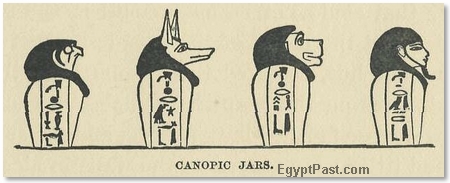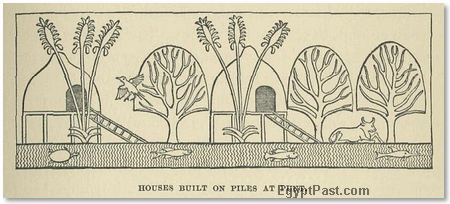Previous file
| Next: Education in Ancient Egypt
EGYPTIAN CITIES
Canopic Jars The Egyptian economy and way of life was based largely on the cultivation of the fields and the raising of cattle. Nevertheless ancient Egypt developed many large and important cities, which were centers of trade, religious worship, and administration. The cities of Egypt rank according to two standards: religious and political. Each nomos (local administrative unit such as a county) had its chief city, its principal deity and cult. The principal places in Upper Egypt were the following: Syene, (Egyptian: Sun), a strategic point on the southern frontier; Elephantine (Egyptian: Abu), a place of trade; Ombos, (Egyptian: Nubi), devoted to the peculiar dual worship of Sebek and Horus; Silsilis (Egyptian: Chenu), with valuable quarries; Edfu, (Egyptian: Teb), devoted to Horus and an important place in Egyptian mythology; Esneh (Egyptian: Seen), Latopolis, the religious capital of the third nomos; Elkab (Egyptian: Nechent), Eileithyia, a place of pilgrimage, devoted to Nechabt, the protecting goddess of the south ; Erment (Egyptian: On), Hermonthis, the forerunner of Thebes (called Us, Nu, Nu-Amon by the Egyptians and by the Hebrews No-Amon), the most powerful city of Egypt, though neither the most ancient nor most sacred; Koptos (Qobti), devoted to the Greek god Pan, a place of importance in the Red Sea trade (since the caravan route started thence for Koser), and valuable for its quarries of hard dark stone; Chemmis, Panopolis, modern Akhmim, was devoted to the same deity ; Denderah in the sixth nomos was an important religious center, devoted to Hathor, and contained a temple whose foundation is ascribed to the earliest times; Abydos (see Memmnonium), the most holy place in Egypt on account of its tomb of Osiris; Thinis (Ten), the native place of Manes, the first king; Kau el-Kebir, Du Qau, Antaeopolis, the capital of the twelfth nomos ; Sint, Saul, Lycopolis, devoted to Anubis, seat of the mighty dynasties of the Middle Kingdom, and beyond value; Chmunu, modern Aschmunen, Greek Hermopolis, an important religious center; Tell el-Amarna, the city of the heretical King Amenophis IV., the place where many cuneiform tablets were discovered in 1887; Beni Has-an (see HASAN), in the sixteenth nomos, containing tombs from the twelfth dynasty, and the SPEOS ARTEMIDOS (q. v.); Ahnes, Chenensu, Heracleopolis, of great importance on account of its mythological connections ; and the FAYUM (q. v.) belonging to the twentieth nomos. The sites of these places are well identified, but the same is not true of many of the large cities of the Delta. 
Houses Built on Piles Worthy of mention are Memphis, Men-nofer, the capital chosen by Menes in uniting the "two lands" ; On, Heliopolis, Hebrew Beth-Shemesh, the most learned city of the land, and next to Abydos in sanctity; Sais, San, the seat of the Libyan rulers, and the resort of Greek scholars; Sebennytus, the seat of the thirtieth dynasty, and the reputed birthplace of the historian Manetho; Mendes, Ded, and Busiris, localities important in the Osiris-myth; Bubastis, Pa-Bast, Hebrew PI-Beseth (q. v.), a city of great antiquity, and a seat of the Hyksos kings; Tanis, nail, one of the most important cities in Egyptian history; Avaris, supposed to be Pelusium (p. v.), the last Hyksos stronghold Zar, a border fortress ; and Pithom, Pa-Turn, Succoth, Heroopolis, one of the cities built by the Israelites for Ramses II. |
pyramids Egypt Mummies Search Engines Link Report |
|
Egyptian Cities | Egyptian Education | Ancient Egypt | egyptian clothing | Egyptian Houses | The Egyptians | Egyptian Family Life | Egypt and its Neighbours | Government in Ancient Egypt | Egyptian History | Military | Organization of Ancient Egypt | Recreation | Egyptian Religion | Pyramids | About | Privacy Policy | Site News | Site Map EgyptPast.com - Facts and Information About the History of Ancient Egypt - |
|